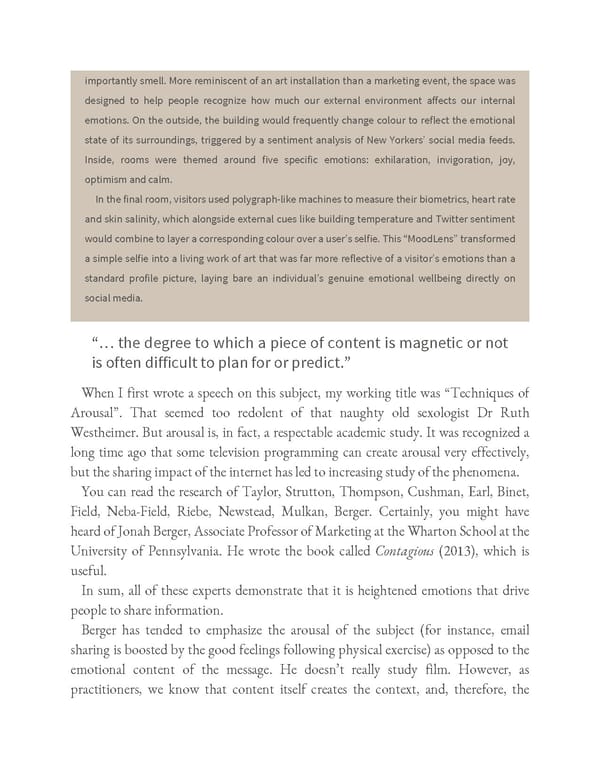importantly smell. More reminiscent of an art installation than a marketing event, the space was designed to help people recognize how much our external environment affects our internal emotions. On the outside, the building would frequently change colour to reflect the emotional state of its surroundings, triggered by a sentiment analysis of New Yorkers’ social media feeds. Inside, rooms were themed around five specific emotions: exhilaration, invigoration, joy, optimism and calm. In the final room, visitors used polygraph-like machines to measure their biometrics, heart rate and skin salinity, which alongside external cues like building temperature and Twitter sentiment would combine to layer a corresponding colour over a user’s selfie. This “MoodLens” transformed a simple selfie into a living work of art that was far more reflective of a visitor’s emotions than a standard profile picture, laying bare an individual’s genuine emotional wellbeing directly on social media. “… the degree to which a piece of content is magnetic or not is often difficult to plan for or predict.” When I first wrote a speech on this subject, my working title was “Techniques of Arousal”. That seemed too redolent of that naughty old sexologist Dr Ruth Westheimer. But arousal is, in fact, a respectable academic study. It was recognized a long time ago that some television programming can create arousal very effectively, but the sharing impact of the internet has led to increasing study of the phenomena. You can read the research of Taylor, Strutton, Thompson, Cushman, Earl, Binet, Field, Neba-Field, Riebe, Newstead, Mulkan, Berger. Certainly, you might have heard of Jonah Berger, Associate Professor of Marketing at the Wharton School at the University of Pennsylvania. He wrote the book called Contagious (2013), which is useful. In sum, all of these experts demonstrate that it is heightened emotions that drive people to share information. Berger has tended to emphasize the arousal of the subject (for instance, email sharing is boosted by the good feelings following physical exercise) as opposed to the emotional content of the message. He doesn’t really study film. However, as practitioners, we know that content itself creates the context, and, therefore, the
 Ogilvy on Advertising in the Digital Age Page 141 Page 143
Ogilvy on Advertising in the Digital Age Page 141 Page 143